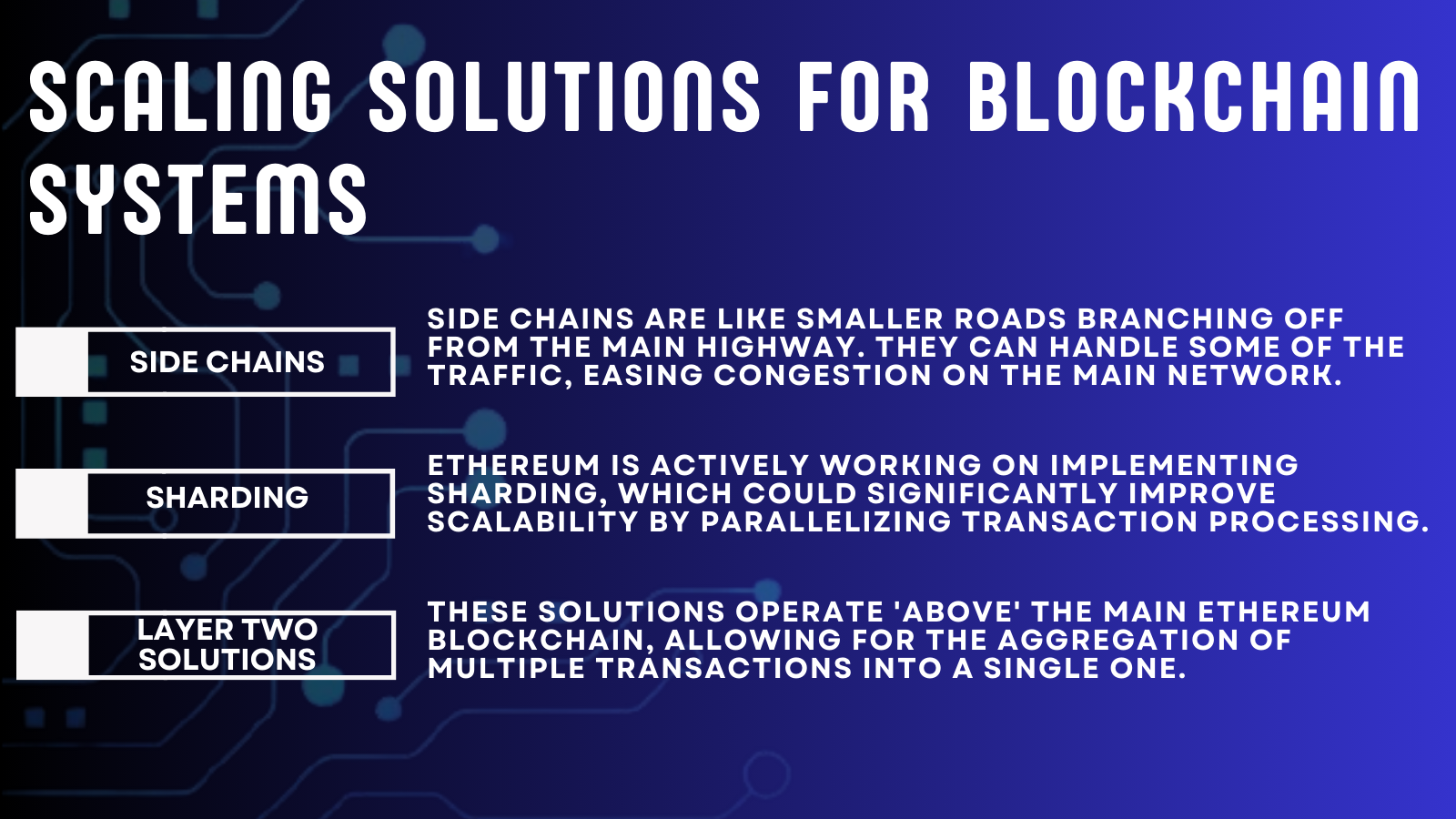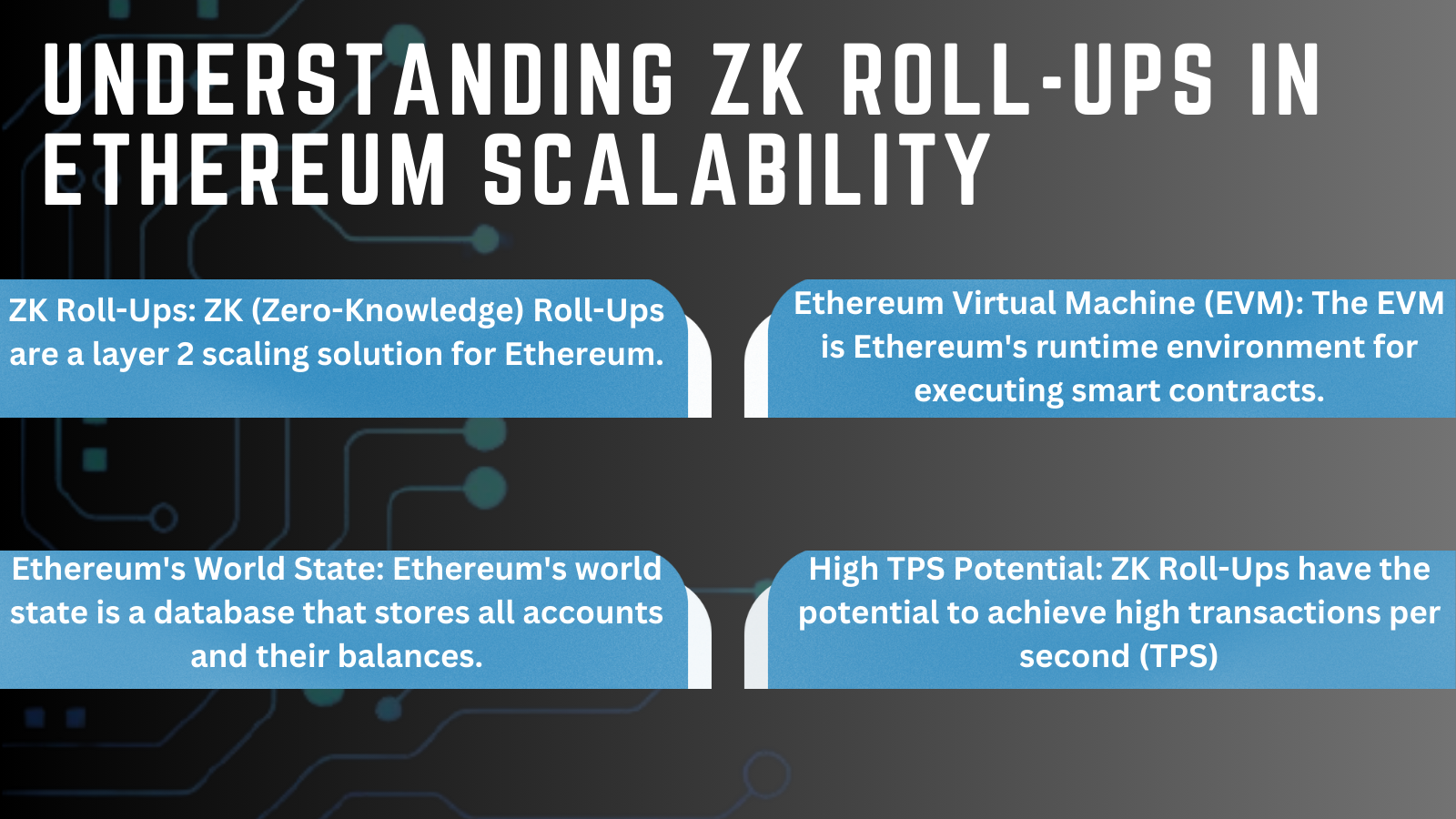Ethereum, like many popular blockchain networks, faces scalability issues. Scalability refers to the ability of a system to handle increased workload efficiently. As more users join Ethereum and the number of transactions goes up, the network can become slower and transaction fees can increase.
A simple analogy is thinking of Ethereum as a highway. If too many cars (transactions) try to use it simultaneously, it can lead to congestion, slowing down the entire system.
Potential solutions such as boosting the gas limit or adjusting block times can be compared to widening the highway or spacing out the cars. However, there are constraints to this approach. Simply enlarging blocks or slowing them down can risk Ethereum's decentralization and inflate operational costs for network node operators.
Scaling Solutions for Blockchain Systems
To tackle these challenges, developers are exploring various solutions. Some of them are:
- Side Chains
Side chains are like smaller roads branching off from the main highway. They can handle some of the traffic, easing congestion on the main network.
An example is Polygon (formerly Matic Network), which acts as a side chain to Ethereum, helping it process more transactions efficiently.
- Sharding
Sharding involves dividing the highway into lanes or 'shards', each capable of handling its own traffic independently. Ethereum is actively working on implementing sharding, which could significantly improve scalability by parallelizing transaction processing.
- Layer Two Solutions
These solutions operate 'above' the main Ethereum blockchain, allowing for the aggregation of multiple transactions into a single one. This reduces congestion on the main network while maintaining security.
Examples include zk rollups and optimistic rollups. For instance, Loopring utilizes zk rollups to bundle transactions, enabling Ethereum to handle more transactions efficiently.

In summary, Ethereum's scalability issues are being addressed through innovative solutions like side chains, sharding, and layer two solutions. These approaches aim to alleviate congestion, reduce transaction costs, and enhance overall network performance. Meanwhile, they preserve Ethereum's decentralized nature and ensure operational sustainability for node operators.
The Modular Vision and Roll-ups
- Overview of Scaling Approaches in Crypto
Cryptocurrencies like Ethereum face challenges as they grow in popularity and usage. These challenges include slower transaction speeds and higher fees.
Ethereum is exploring various approaches to address scalability issues. These include layer 2 solutions like roll-ups, sharding, bridging multiple chains, and implementing modular visions with shared security models.
- Understanding the Architecture of Ethereum Nodes and Roll-Ups
Ethereum Nodes: The Ethereum network consists of many nodes, each maintaining a copy of the entire Ethereum system. Some nodes are involved in mining to secure the network.
Roll-ups: Roll-ups are a key component in Ethereum's scaling solutions. They periodically settle transactions by interacting with the Ethereum layer 1 (L1) while using their own state and execution mechanisms. Roll-ups maintain their state and execution but rely on Ethereum's infrastructure for transaction settlement.
- Understanding Roll-Ups in Ethereum
Roll-ups, such as zk roll-ups, optimize transaction data in both layer 1 and layer 2 systems. They prioritize data availability and aim to minimize costs.
The Ethereum ecosystem includes various types of roll-ups, such as
-
Volidiums
-
Side chains
-
Volitions
These roll-ups offer flexibility but may introduce complexities in the system.
Roll-Ups and Their Efficiency: An Analogy
When sending cryptocurrency tokens using Ethereum, increased popularity can lead to slower transaction speeds and higher fees. To tackle these challenges, Ethereum is implementing solutions like roll-ups.
Roll-ups act as efficient transaction managers, periodically settling transactions by interacting with the Ethereum network while also managing transactions through their own systems.
Think of roll-ups as self-service kiosks at a busy airport. Instead of waiting in a long line at the main check-in counter (similar to Ethereum layer 1), you use a kiosk (like a roll-up) to check in faster. The kiosk interacts with the airport's main system to finalize your check-in but speeds up the process by handling some tasks independently.
Among roll-ups, zk roll-ups are notable for optimizing transaction data and minimizing costs by focusing on data availability. However, incorporating different roll-up types can introduce complexity to the Ethereum ecosystem.
In summary, Ethereum is exploring various scaling approaches like roll-ups to enhance transaction speeds and reduce fees. Roll-ups act as efficient assistants in managing transactions, although they also introduce some complexities to the system.
ZK Roll-Ups
Understanding ZK Roll-Ups in Ethereum Scalability

-
ZK Roll-Ups: ZK (Zero-Knowledge) Roll-Ups are a layer 2 scaling solution for Ethereum. They aim to improve scalability by aggregating multiple transactions off-chain and submitting a single proof on-chain to verify their validity.
-
Structure of Ethereum's World State: Ethereum's world state is a database that stores all accounts and their balances. ZK Roll-Ups interact with this world state to process transactions efficiently.
-
Role of Ethereum Virtual Machine (EVM): The EVM is Ethereum's runtime environment for executing smart contracts. ZK Roll-Ups utilize the EVM to process transactions and generate proofs for state transitions.
-
High TPS Potential: ZK Roll-Ups have the potential to achieve high transactions per second (TPS) by offloading computational work from Ethereum nodes to sequencers, resulting in improved scalability.
Understanding State Diff Data and Complexity Theory
In layer 2 blockchain networks, participants need a way to track changes in the world state efficiently. State diff data provides a mechanism for participants to build and maintain up-to-date copies of the world state.
Complexity theory categorizes algorithms based on their time and memory complexity. It uses big O notation to analyze the performance of algorithms.
For example, sorting algorithms like ‘bubble sort’ and ‘merge sort’ have different time complexities, impacting their efficiency.
Complexity Theory and Scaling Considerations in ZK Roll-Ups
-
Sorting Algorithms Example: Sorting algorithms serve as illustrative examples of complexity theory. Algorithms like bubble sort have quadratic time complexity, while algorithms like merge sort have better time complexity.
-
Scaling Considerations in ZK Roll-Ups: ZK Roll-Ups require computational work from sequencers, provers, and verifiers. Factors like state size, proof generation intervals, and data availability impact the efficiency and cost savings of ZK Roll-Ups.
Enhancing Ethereum's Scalability with ZK Proof Systems and Layer 2 Solutions
Zero-knowledge proof systems like SNARKs, STARKs, and Bulletproofs bring forth a new era of transparency, universality, and post-quantum security. These advanced proof systems pave the way for ZK Roll-Ups, ensuring scalability without compromising security.
Layer 2 Scaling Solutions, including ZK Roll-Ups, stand as pillars in Ethereum's quest for scalability. By aggregating transactions off-chain and submitting proofs on-chain, ZK Roll-Ups hold promise for significant scalability improvements.
Moreover, the advent of modular chains and layer three solutions hints at exciting possibilities for future blockchain scalability.
Harnessing ZK Roll-Ups, Complexity Theory, and ZK Proof Systems
Imagine you're a student in a bustling classroom where the teacher is faced with the challenging task of efficiently grading a host of assignments. Instead of tediously inspecting each assignment individually (akin to Ethereum nodes processing transactions), the teacher could enlist the help of a grading assistant (similar to a ZK Roll-Up sequencer).
This assistant would intelligently group similar assignments, grade them in batches, and then present a single comprehensive report (proof) to the teacher (representing the Ethereum network).
In understanding the efficiency of different grading methods, complexity theory offers valuable insights. For instance, employing a bubble sort would entail scrutinizing each assignment individually, consuming considerable time, especially with a large volume of assignments.
Conversely, employing a merge sort would involve organizing assignments into manageable piles and then merging them, resulting in a more rapid grading process.
Zero-knowledge proof systems serve as guardians of privacy and security, ensuring that only essential information is divulged to verify transactions. This concept mirrors the notion of providing the teacher with just enough information to authenticate the graded assignments without exposing the personal details of the students.
In essence, ZK Roll-Ups emerge as a beacon of hope for Ethereum's scalability challenges by consolidating transactions off-chain and leveraging efficient proof systems. Complexity theory provides a lens through which we can assess the efficacy of various algorithms, while zero-knowledge proof systems uphold the principles of security and privacy within layer 2 scaling solutions.
Conclusion
As we navigate Ethereum's scalability challenges, the combination of ZK Roll-Ups, complexity theory, and zero-knowledge proof systems emerges as a powerful solution. With these tools working together, Ethereum can overcome obstacles while ensuring the utmost security and privacy.
Let's continue to promote innovation and collaboration, embracing the potential these advancements bring. Together, we're shaping a future where Ethereum thrives, offering scalability and security hand in hand, and transforming the blockchain landscape for the better.